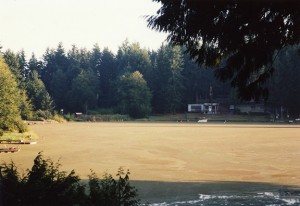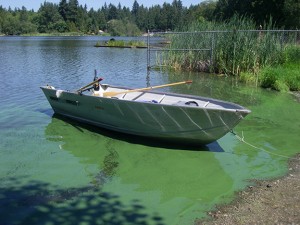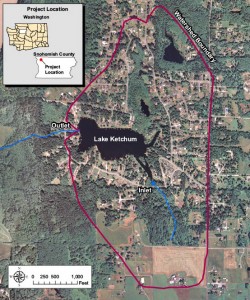by Marisa Burghdoff and Gene Williams, Snohomish County Public Works Surface Water Management
Lake Ketchum is a beautiful 25-acre lake in northern Snohomish County just a few miles from Puget Sound. With a fairly small watershed and limited residential development, it is not the type of lake you would expect to have serious water quality problems. Unfortunately, Lake Ketchum is the most polluted lake in Snohomish County and one of the worst in the state. After living with severe water quality problems for decades, the residents of Lake Ketchum, together with Snohomish County, have a plan to “turn back the clock” and restore the lake so residents and visitors can enjoy it once again.
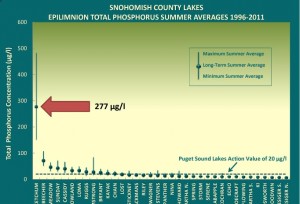 Until the 1940s, the Lake Ketchum watershed was largely undeveloped, and the lake served as a drinking water source for the City of Stanwood. By the 1970s and 1980s, the lake’s water quality had declined markedly. Algal blooms and thick floating plants, like duckweed and azolla, became common and sometimes covered the entire lake. Recently, severe and persistent blooms of potentially toxic cyanobacteria (blue-green algae) have plagued the lake. The lake has had toxin levels exceeding the state recreational guideline in four out of the last five years, with blooms often lasting months at a time.
Until the 1940s, the Lake Ketchum watershed was largely undeveloped, and the lake served as a drinking water source for the City of Stanwood. By the 1970s and 1980s, the lake’s water quality had declined markedly. Algal blooms and thick floating plants, like duckweed and azolla, became common and sometimes covered the entire lake. Recently, severe and persistent blooms of potentially toxic cyanobacteria (blue-green algae) have plagued the lake. The lake has had toxin levels exceeding the state recreational guideline in four out of the last five years, with blooms often lasting months at a time.
The underlying source of the water quality problems at Lake Ketchum is the incredible amount of nutrients – especially phosphorus – found in the lake. The summer phosphorus levels in the upper waters, or epilimnion, average around 277 µg/l with peaks over 600 µg/l. These levels are almost 14 times higher than the state action level for Puget Sound lakes of 20 µg/l. The phosphorus concentrations in the bottom waters, or hypolimnion, are even more alarming, with a long-term summer average of 1,746 µg/l and values as high as 3,780 µg/l.
In a 1996 study, the original source of pollution was identified as a former dairy farm whose land drains to the Lake Ketchum inlet stream. The farmer had been accepting chicken manure from local farms for years and spreading it on a field, unaware of the impact it could have on the lake’s water quality. Runoff from the farm had phosphorus concentrations that averaged 10,000 µg/l. Over time, phosphorus from the farm accumulated in the lake bottom, where it is recycled each summer during periods of low oxygen, causing the extreme phosphorus levels now observed in the lake.
In response to continued severe toxic algae blooms and the ongoing frustration of Lake Ketchum residents, Snohomish County Surface Water Management, assisted by Tetra Tech Inc., began in 2010 to work toward a clean-up plan for Lake Ketchum (funded in part by the Department of Ecology’s Freshwater Algae Control Grant).
The study’s first goal was to identify the current sources and amounts of phosphorus in the lake, using a two-layer phosphorus model. The findings show that the total annual load of phosphorus to the lake is approximately 623 kg (1374 pounds) of phosphorus per year — extremely high for a small lake. To put these amounts into perspective, there would need to be less than 15 kilograms of phosphorus in the entire lake without any additional inputs to meet the target summer phosphorus concentration of 40 µg/l for the lake.
The model also revealed that internal cycling of phosphorus from the lake bottom is now by far the largest source, accounting for 73% of the annual total (see figure). The sediment-release rate (SRR) of phosphorus from the lake bottom was up to 45 mg-P/ m² per day. High rates like this are rare and found only in hyper-eutrophic lakes that have long been polluted. Meanwhile, the inlet stream now accounts for only 23% of the total phosphorus load to the lake.
The second goal of the study was to evaluate several lake restoration methods to identify the most feasible and effective actions. To improve lake quality, the study concluded that internal cycling from the lake’s sediments must be addressed first. The most effective method identified was a whole-lake aluminum sulfate (alum) treatment. Alum permanently binds phosphorus in the lake water and the sediments. Alum treatments are the most successful method used around the world to inactivate phosphorus and alleviate algae problems. The cost of a single whole-lake alum treatment for Lake Ketchum was estimated at $194,000.
The other major source – the inlet draining the farm – also had to be addressed to restore the lake. The best method would be to modify or remove soils from the farm, but this is not possible with the current landowners. The only remaining option is to intercept the phosphorus as it reaches the lake. Two methods were examined, including a small mechanical alum injection plant and small annual alum water column treatments in the lake. The impacts of the alternatives were modeled (see figure) and both were found to meet the water quality target of 40 µg/l, but the injection system would have been much more expensive than the annual alum treatments. The final recommendation was to conduct a whole-lake sediment inactivation treatment followed by annual water column treatments for a total cost of $338,000 over four years. Additional funds would be needed for water quality monitoring, as well as outreach and education to shoreline and wetland landowners.
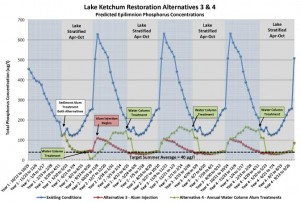 After decades of living with the impacts of severe phosphorus pollution, the residents of Lake Ketchum are now equipped with a plan (Lake Ketchum Algae Control Plan) to improve the quality of their lake. Residents hope they can find funding to implement the plan and return the lake to its historic recreational potential. For more information on this project, please visit www.lakes.surfacewater.info.
After decades of living with the impacts of severe phosphorus pollution, the residents of Lake Ketchum are now equipped with a plan (Lake Ketchum Algae Control Plan) to improve the quality of their lake. Residents hope they can find funding to implement the plan and return the lake to its historic recreational potential. For more information on this project, please visit www.lakes.surfacewater.info.


